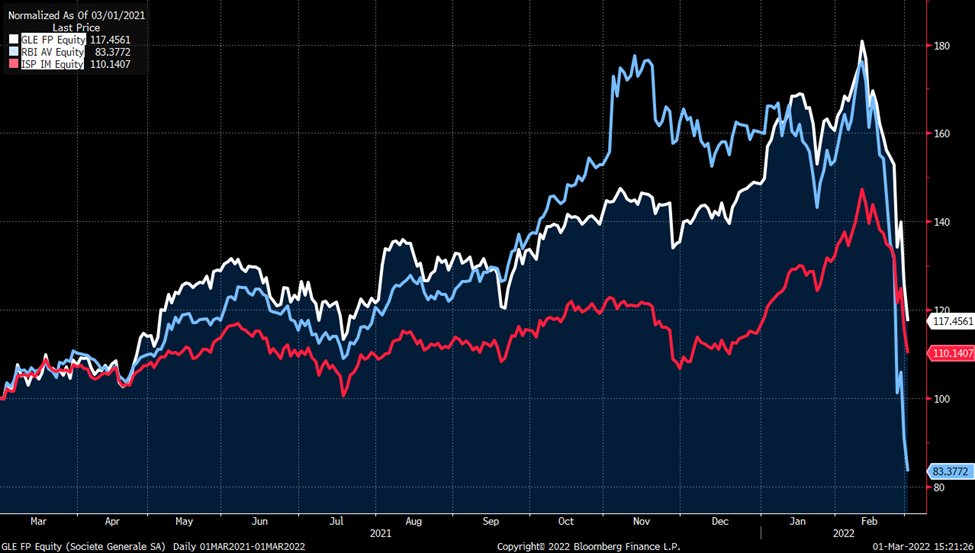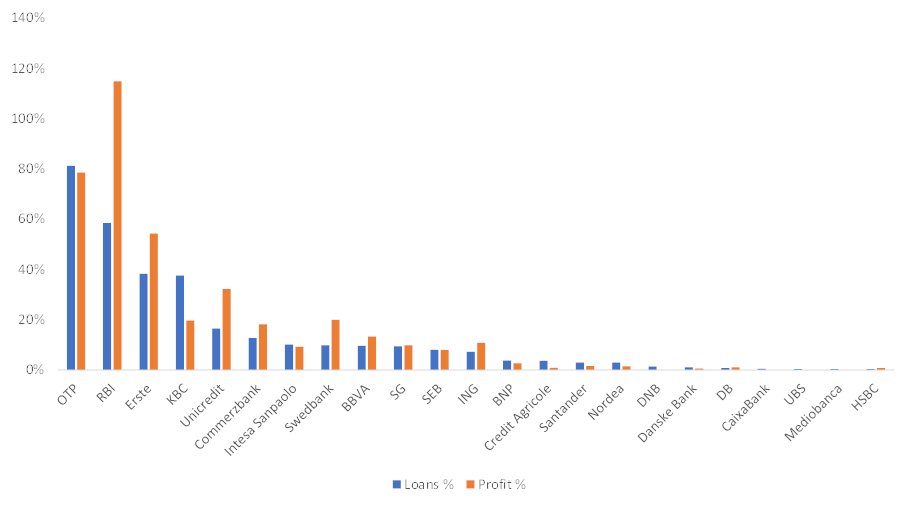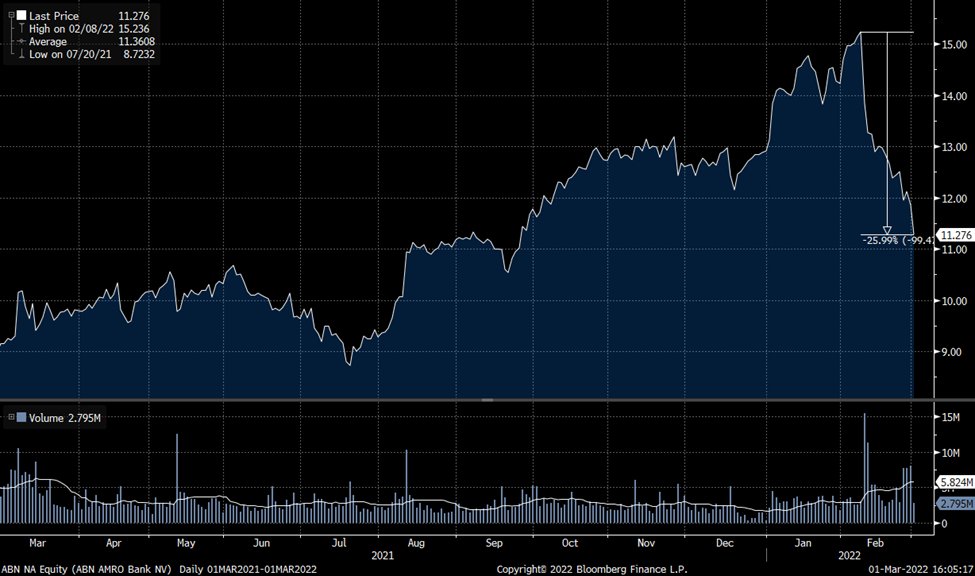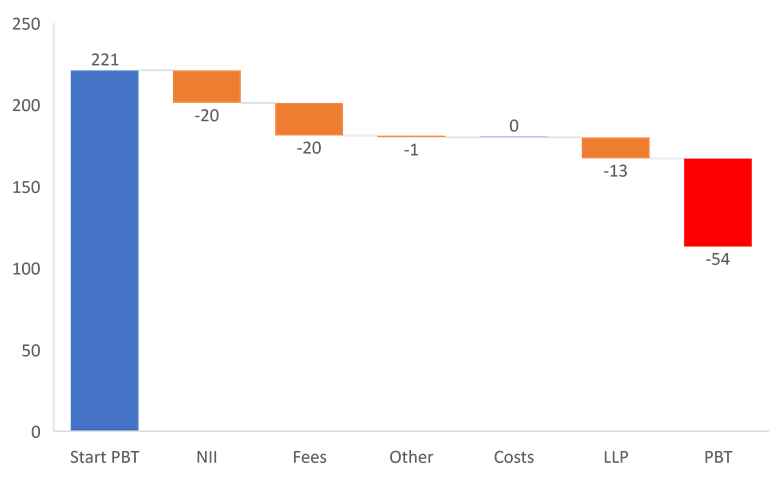Thread by Johannes Borgen
- Tweet
- Mar 1, 2022
- #CentralBank #Politics
Thread
What’s going on with European banks and what are the risks from the Ukrainian conflict?
I know it might sound slightly irrelevant, considering all is going on, but the past few days have shown that financial plumbing can have huge ramifications…
So, a thread.
I know it might sound slightly irrelevant, considering all is going on, but the past few days have shown that financial plumbing can have huge ramifications…
So, a thread.
1st, a chart to illustrate the extent of the damages, with three examples:
- a bank with a substantial exposure to Rus+Ukr (RBI, 50% of profits from the region)
- a bank with reasonable exposure (SG, 5% of profits)
- a bank with minimal exposure (Intesa)
- a bank with a substantial exposure to Rus+Ukr (RBI, 50% of profits from the region)
- a bank with reasonable exposure (SG, 5% of profits)
- a bank with minimal exposure (Intesa)
In the case of RBI we have a 50% peak to valley -consistent with a loss of all earnings – but SG (-35%) and Intesa (-25%) are hit proportionally more.
What are the risks banks are facing and how can this be explained?
What are the risks banks are facing and how can this be explained?
There are four main problems for European banks:
1) direct exposure to Rus + Ukr
2) direct exposure to connected regions (CEE)
3) macro impacts (banks are always sensitive to macro) and
4) the possible curveball no one saw coming.
1) direct exposure to Rus + Ukr
2) direct exposure to connected regions (CEE)
3) macro impacts (banks are always sensitive to macro) and
4) the possible curveball no one saw coming.
Let’s start with direct exposures. The EBA reports give useful info. There are only 5 EBA banks for which Russia is in the top 10 list of countries and 1 for which Ukraine is. Starting with Russia, split by type of borrower and all expressed as % of regulatory equity (CET1)
Others have exposure above 1bn (notably ING, Intesa, CredAg or Commerzbank) but are not in EBA data.
On the face of it, those numbers are a bit scary because wiping out 50% or more of CET1 would be a very serious problem.
On the face of it, those numbers are a bit scary because wiping out 50% or more of CET1 would be a very serious problem.
But this is where consolidated accounting is actually super unhelpful: it is very different to own that Russian exposure in Russia or in Europe: a Russian loan held at Intesa, for example, could default and result in a loss.
A wave of default of Russian loan at RBI, however, would probably put RBI’s subsidiary in serious difficulty.
RBI would then decide to let its subsidiary fail or... invest more money in it.
In the current context the choice is easy…
RBI would then decide to let its subsidiary fail or... invest more money in it.
In the current context the choice is easy…
So ultimately, for those banks with a sub in Russia, loan losses or Putin nationalizing the bank for 0 as retaliation for Western sanctions (a scenario which is certainly not far-fetched anymore), is actually the same risk: losing all funding invested in Russia.
And since 2014 (Crimea + 1st wave of sanctions), European banks have learned their lessons: none has any significant group funding to Russia, the sub are funded locally (deposits, interbank, local bonds) which means loan losses would be shared with local investors
Let me detail the wipeout scenario for the most exposed bank: RBI. They have approx. 11.8bn CET1, if you wipe-out Russia & Ukraine only 9.1 left. BUT they would also lose RWAs (from 89.9bn6€ to 74.4bn€ approximately.)
In practice, their CET1 ratio would only go down from 13.1% to 12.2%. This is bad, but not horrifying. More importantly, it tells a totally different story from the same analysis done on a consolidated basis!
What about the regions most connected to Russia, i.e., the CEE (including Turkey)? Clearly, you can’t expect a massive Russian recession with no impact on close neighbors. Here are the exposures, in % of loans and % of profits.
Obviously, this isn’t the same a direct exposure to Russia – so any haircut will not be 100% -far from it. But you can still spot banks like KBC or Swedbank, with minimal Russian risk - but clear indirect CEE risk.
But let’s look at ABN Amro now (just an example): the Dutch bank has no Russia or CEE exposure. Yet, the share price doesn’t look great since beginning of Feb (PTV of -26%). That’s where our two other risks kick in.
Needless to say the Ukrainian conflict will have macro consequences. To keep it obvious: refugees, commodity prices, military spending, spillover from Russia.. But there are also expectations that this could slow the change of course of central banks – a crucial factor for banks.
The following chart is quite telling: market pricing suggests we’ve gone from an expected 50bps rise (on feb 8th, peak of bank stock prices) by YE 2022 to almost 0 today.
Unfortunately, rates move are not the only factor here.
We’re clearly facing the possibility of a stagflation, with a macro shock combined by CB afraid to reverse monetary policy or unable to stop inflation on commodity prices.
We’re clearly facing the possibility of a stagflation, with a macro shock combined by CB afraid to reverse monetary policy or unable to stop inflation on commodity prices.
Here’s a recent estimate of what stagflation could do to the combined P&L of a sample of large listed banks (in 2023 Eur bn). This is a downside scenario, not a forecast, but it’s not entirely disconnected from what we’ve seen on the bank index (-19% PTV)
Enough macro, what about possible curveballs? By definition, no one knows where they’ll come from. But we’re in a stunning environment, one that was largely unexpected a month ago, so caution is advised. Here are a few things that could go bad.
A bank could do an illicit (sanctioned) trade – not even on purpose, just because there are so many new rules happening in so little time, or because of a rogue agent.
As BNP remembers, this can be expensive.
As BNP remembers, this can be expensive.
With all financial plumbing (SWIFT, correspondent banking, payments from Russia) in a storm, Herstatt risk is not entirely excluded: a large settlement problem could trigger big losses.
And, of course, with all the volatility and inevitable losses, especially for leveraged investors, we could see funds blow up – and some banks taking a hit.
I’m sure Credit Suisse remembers what I’m talking about.
I’m sure Credit Suisse remembers what I’m talking about.
The bottom line: many people do not understand why banks are down 20%.
It may feel overdone – and it certainly is for some banks – but one thing is certain: the consequences of this conflict, especially if it drags on for a long period, go beyond direct Russian risk.
It may feel overdone – and it certainly is for some banks – but one thing is certain: the consequences of this conflict, especially if it drags on for a long period, go beyond direct Russian risk.
Mentions
See All
Matthew C. Klein @m_c_klein
·
Mar 1, 2022
Worth reading the whole thing
Alex Turnbull @alexbhturnbull
·
Mar 1, 2022
Superb thread






